Gold-Coated Temperature Optical Fiber Sensor Based on a Mach–Zehnder Interferometer for Photovoltaic Monitoring
Abstract
1. Introduction
2. Materials and Methods
2.1. Sensor Principle
2.2. Sensor Fabrication
2.3. Experiment Setup and Method
3. Results
3.1. Bare Tapered Optical Fiber
3.2. Gold-Coated Tapered Optical Fiber
4. Discussion
5. Conclusions
Author Contributions
Funding
Institutional Review Board Statement
Informed Consent Statement
Data Availability Statement
Conflicts of Interest
Abbreviations
| TOF | Tapered Optical Fiber |
| FBG | Fiber Bragg Grating |
| PV | Photovoltaic |
| MZI | Mach–Zehnder interferometer |
| SPR | Surface Plasmon Resonance |
| SEM | Scanning Electron Microscope |
| EDS | Energy Dispersive X-ray Spectroscopy |
References
- Jafarishad, H.; Li, M.; Shen, Y.; Takher, P.; Liu, Y. Intensity-modulated optical fibre strain sensor for continuous measurements of below-the-surface food deformation during drying. Biosyst. Eng. 2024, 238, 115–127. [Google Scholar] [CrossRef]
- Wang, Y.; Wu, Y.; Tang, M. Optical fiber Fabry-Perot strain sensor based on metal welding. Opt. Fiber Technol. 2024, 82, 103629. [Google Scholar] [CrossRef]
- Liu, C.; Chen, H.; Chen, Q.; Gao, Z.; Wu, B.; Fan, X.; Ma, M. Sagnac interferometer-based optical fiber strain sensor with exceeding free spectral measurement range and high sensitivity. Opt. Laser Technol. 2023, 159, 108935. [Google Scholar] [CrossRef]
- Zawisza, R.; Jaroszewicz, L.R.; Mikulic, P.; Bock, W.J. An interferometric structure with a dual-resonance long period grating for strain sensing. Opto-Electron. Rev. 2018, 26, 325–328. [Google Scholar] [CrossRef]
- Aime, L.F.J.; Kissinger, T.; James, S.W.; Chehura, E.; Varzeletti, A.; Tatam, R.P. High sensitivity pressure measurement using optical fibre sensors mounted on a composite diaphragm. Opt. Express 2021, 29, 4105–4123. [Google Scholar] [CrossRef]
- Korec, J.; Stasiewicz, K.A.; Jaroszewicz, L.R.; Piecek, W.; Kula, P. Temperature and voltage sensing based on a tapered optical fiber device with the liquid crystal cladding. Opt. Fiber Technol. 2020, 56, 102190. [Google Scholar] [CrossRef]
- Leal-Junior, A.; Blanc, W. Temperature-insensitive and cost-effective distributed NP-Doped optical fiber sensors. Opt. Fiber Technol. 2024, 88, 103995. [Google Scholar] [CrossRef]
- Hu, D.J.J.; Lim, J.L.; Jiang, M.; Wang, Y.; Luan, F.; Shum, P.P.; Huifeng, W.; Tong, W. Long period grating cascaded to photonic crystal fiber modal interferometer for simultaneous measurement of temperature and refractive index. Opt. Lett. 2012, 37, 2283–2285. [Google Scholar]
- Yang, Y.; Tian, D.; Chen, K.; Zhou, X.; Gong, Z.; Yu, Q. A Fiber-Optic Displacement Sensor Using the Spectral Demodulation Method. J. Light. Technol. 2018, 36, 3666–3671. [Google Scholar] [CrossRef]
- Wu, J.; Miao, Y.; Song, B.; Lin, W.; Zhang, K.; Zhang, H.; Liu, B.; Yao, J. Simultaneous measurement of displacement and temperature based on thin-core fiber modal interferometer. Opt. Commun. 2015, 340, 136–140. [Google Scholar] [CrossRef]
- Eftimov, T.; Janik, M.; Koba, M.; Śmietana, M.; Mikulic, P.; Bock, W. Long-Period Gratings and Microcavity In-Line Mach Zehnder Interferometers as Highly Sensitive Optical Fiber Platforms for Bacteria Sensing. Sensors 2020, 20, 3772. [Google Scholar] [CrossRef]
- Nurlankyzy, M.; Kantoreyeva, K.; Myrkhiyeva, Z.; Ashikbayeva, Z.; Baiken, Y.; Kanayeva, D.; Tosi, D.; Bekmurzayeva, A. Label-free optical fiber biosensor for the detection of CD44-expressing breast cancer cells. Sens. Bio-Sens. Res. 2024, 44, 100661. [Google Scholar] [CrossRef]
- Zhang, W.; Ni, X.; Wang, J.; Ai, F.; Luo, Y.; Yan, Z.; Liu, D.; Sun, Q. Microstructured Optical Fiber Based Distributed Sensor for In Vivo Pressure Detection. J. Light. Technol. 2019, 37, 1865–1872. [Google Scholar] [CrossRef]
- Yue, Y.; Chen, G.; Long, J.; Ren, L.; Zhou, K.; Li, X.; Xu, Y.; Tang, Y. Characterization of a Raman-based distributed fiber optical temperature sensor in liquid nitrogen. Superconductivity 2022, 4, 100028. [Google Scholar] [CrossRef]
- Manoj, K.S.; Sharma, R.K.; Kumar, S.; Kishore, J.; Nathwani, R.K.; Gupta, A.M.; Kumar, A.; Kumar, A.; Bhatnagar, V.K.; Prakash, O.; et al. Studies on thermal profile measurement and fire detection in a power supply cable of a synchrotron radiation source by Raman optical fiber distributed temperature sensor system. Opt. Fiber Technol. 2022, 73, 103020. [Google Scholar]
- Ren, Y.; Song, H.; Cai, Q.; Cai, Z.; Liu, Y.; Wang, B. Modeling analysis and experimental study on epoxy packaged FBG sensor for cryogenic temperature measurement. Opt. Fiber Technol. 2024, 84, 103710. [Google Scholar] [CrossRef]
- Ju, S.; Watekar, P.R.; Han, W.-T. Enhanced Sensitivity of the FBG Temperature Sensor Based on the PbO-GeO2-SiO2 Glass Optical Fiber. J. Light. Technol. 2010, 28, 2697–2700. [Google Scholar] [CrossRef]
- Rahaman, M.A.; Chambers, T.L.; Fekih, A.; Wiecheteck, G.; Carranza, G.; Possetti, G.R.C. Floating photovoltaic module temperature estimation: Modeling and comparison. Renew. Energy 2023, 208, 162–180. [Google Scholar] [CrossRef]
- Ye, Z.; Nobre, A.; Reindl, T.; Luther, J.; Reise, C. On PV module temperatures in tropical regions. Sol. Energy. 2013, 88, 80–87. [Google Scholar] [CrossRef]
- Jeong, H.; Kwon, G.-R.; Lee, S.-W. Deterioration Diagnosis of Solar Module Using Thermal and Visible Image Processing. Energies 2020, 13, 2856. [Google Scholar] [CrossRef]
- Chiang, W.-H.; Wu, H.-S.; Wu, J.-S.; Lin, S.-J. A Method for Estimating On-Field Photovoltaics System Efficiency Using Thermal Imaging and Weather Instrument Data and an Unmanned Aerial Vehicle. Energies 2022, 15, 5835. [Google Scholar] [CrossRef]
- Dhanalakshmi, S.; Chakravartula, V.; Narayanamoorthi, R.; Kumar, R.; Dooly, G.; Duraibabu, D.B.; Senthil, R. Thermal management of solar photovoltaic panels using a fibre Bragg grating sensor-based temperature monitoring. Case Stud. Therm. Eng. 2022, 31, 101834. [Google Scholar] [CrossRef]
- Gui, X.; Li, Z.; Fu, X.; Guo, H.; Wang, Y.; Wang, C.; Wang, J.; Jiang, D. Distributed Optical Fiber Sensing and Applications Based on Large-Scale Fiber Bragg Grating Array: Review. J. Light. Technol. 2023, 41, 4187–4200. [Google Scholar] [CrossRef]
- Yu, T.; Ren, C.; Jia, Y.; Li, J.; Zhang, J.; Xu, Y.; Yan, B.; Zhang, M.; Qiao, L.; Wang, T.; et al. Photovoltaic Panel Temperature Monitoring and Prediction by Raman Distributed Temperature Sensor With Fuzzy Temperature Difference Threshold Method. IEEE Sens. J. 2021, 21, 373–380. [Google Scholar] [CrossRef]
- Nivelle, P.; Maes, L.; Poortmans, J.; Daenen, M. In situ quantification of temperature and strain within photovoltaic modules through optical sensing. Prog. Photovolt. Res. Appl. 2023, 31, 173–179. [Google Scholar] [CrossRef]
- Santolin, E.A.; Lourenço Junior, I.D.; Corte, V.D.; Silva, J.C.C.D.; Oliveira, V.D. Thermal Monitoring of Photovoltaic module using Optical Fiber Sensors. J. Microw. Optoelectron. Electromagn. Appl. 2016, 15, 333–348. [Google Scholar] [CrossRef]
- Alonso-Murias, M.; Monzón-Hernández, D.; Antonio-Lopez, E.; Schülzgen, A.; Amezcua-Correa, R.; Villatoro, J. Hybrid optical fiber Fabry-Perot interferometer for nano-displacement sensing. Opt. Laser Technol. 2022, 155, 108426. [Google Scholar] [CrossRef]
- Tong, R.; Zhao, Y.; Hu, H.; Qu, J. Large measurement range and high sensitivity temperature sensor with FBG cascaded Mach-Zehnder interferometer. Opt. Laser Technol. 2020, 125, 106034. [Google Scholar] [CrossRef]
- Monteiro, C.S.; Ferreira, M.; Mendes, J.P.; Coelho, L.C.C.; Silva, S.O.; Frazão, O. Optical fiber flowmeter based on graphene oxide coated michelson interferometer. Sens. Actuators A Phys. 2023, 363, 114775. [Google Scholar] [CrossRef]
- Domínguez-Cruz, R. Temperature sensor based on an asymmetric two-hole fiber using a Sagnac interferometer. J. Sens. 2018, 2018, 7595106. [Google Scholar] [CrossRef]
- Gabler, T.; Janik, M.; Liao, C.; Myśliwiec, A.; Koba, M.; Jönsson-Niedziółka, M.; Wang, Y.; Śmietana, M. Investigation of liquids with microcavity in-line Mach-Zehnder interferometers—Impact of the microcavity shape on the sensing performance. Opt. Fiber Technol. 2022, 73, 103059. [Google Scholar] [CrossRef]
- Janik, M.; Sosnowska, M.; Gabler, T.; Koba, M.; Myśliwiec, A.; Kutwin, M.; Sawosz-Chwalibóg, E.; Śmietana, M. Life in an optical fiber: Monitoring of cell cultures with microcavity in-line Mach-Zehnder interferometer. Biosens. Bioelectron. 2022, 217, 114718. [Google Scholar] [CrossRef] [PubMed]
- Janik, M.; Eftimov, T.; Koba, M.; Śmietana, M.; Bock, W.J. Tailoring Properties of Microcavity In-Line Mach-Zehnder Interferometer by the Microcavity Enlargement Using Femtosecond Laser. J. Light. Technol. 2019, 37, 4501–4506. [Google Scholar] [CrossRef]
- Bilsel, M.; Navruz, I. Tapered Optical Fiber Sensor for Discrimination of Strain and Temperature. Adv. Electr. Electron. Eng. 2020, 18, 50–56. [Google Scholar] [CrossRef]
- Bhardwaj, V.; Kishor, K.; Sharma, A.C. Tapered optical fiber geometries and sensing applications based on Mach-Zehnder Interferometer: A review. Opt. Fiber Technol. 2020, 58, 102302. [Google Scholar] [CrossRef]
- Guzowski, B.; Łakomski, M. Temperature Sensor Based on Periodically Tapered Optical Fibers. Sensors 2021, 21, 8358. [Google Scholar] [CrossRef]
- Łakomski, M.; Guzowski, B.; Wozniak, A. Fabrication of ultra-long tapered optical fibers. Microelectron. Eng. 2020, 221, 111193. [Google Scholar] [CrossRef]
- Karimi-Alavijeh, H.; Taslimi, A.; Maghsoudian, M.H.; Poorghadiri, M.H.; Kazemzadeh, M. Fabrication of low-loss adiabatic optical microfibers using an attainable arc-discharge fiber tapering setup. Opt. Commun. 2022, 522, 128669. [Google Scholar] [CrossRef]
- Miao, Y.; He, Y.; Ma, X.; Zhang, H.; Song, B.; Yang, X.; Xue, L.; Liu, B.; Yao, J. Low-Temperature Cross-Sensitivity Refractive Index Sensor Based on Single-Mode Fiber with Periodically Modulated Taper. IEEE Sens. J. 2016, 16, 2442–2446. [Google Scholar] [CrossRef]
- Tian, Z.; Yam, S.S.-H. In-Line Abrupt Taper Optical Fiber Mach–Zehnder Interferometric Strain Sensor. IEEE Photonics Technol. Lett. 2009, 21, 161–163. [Google Scholar] [CrossRef]
- Yadav, T.K.; Narayanaswamy, R.; Bakar, M.H.A.; Kamil, Y.M.; Mahdi, M.A. Single mode tapered fiber-optic interferometer based refractive index sensor and its application to protein sensing. Opt. Express 2014, 22, 22802–22807. [Google Scholar] [CrossRef] [PubMed]
- Tian, Z.; Yam, S.S.-H.; Barnes, J.; Bock, W.; Greig, P.; Fraser, J.M.; Loock, H.-P.; Oleschuk, R.D. Refractive Index Sensing with Mach–Zehnder Interferometer Based on Concatenating Two Single-Mode Fiber Tapers. IEEE Photonics Technol. Lett. 2008, 20, 626–628. [Google Scholar] [CrossRef]
- Wen, Z.; Guan, Z.; Dong, J.; Li, H.; Cai, Y.; Gao, S. A Review of Sensitivity Enhancement in Interferometer-Based Fiber Sensors. Sensors 2022, 22, 2506. [Google Scholar] [CrossRef] [PubMed]
- Kim, Y.-J.; Paek, U.-C.; Lee, B.H. Measurement of refractive-index variation with temperature by use of long-period fiber gratings. Opt. Lett. 2002, 27, 1297–1299. [Google Scholar] [CrossRef]
- Yang, N.; Qiu, Q.; Su, J.; Shi, S.-j. Research on the temperature characteristics of optical fiber refractive index. Optik 2004, 125, 5813–5815. [Google Scholar] [CrossRef]
- Al-Qazwini, Y.; Noor, A.S.M.; Yaacob, M.H.; Harun, S.W.; Mahdi, M.A. Experimental realization and performance evaluation of refractive index SPR sensor based on unmasked short tapered multimode-fiber operating in aqueous environments. Sens. Actuators A Phys. 2015, 236, 38–43. [Google Scholar] [CrossRef]
- Luo, W.; Meng, J.; Li, X.; Xie, Q.; Yi, D.; Wang, Y.; Hong, X. Temperature effects on surface plasmon resonance sensor based on side-polished D-shaped photonic crystal fiber. Measurement 2021, 181, 109504. [Google Scholar] [CrossRef]
- Li, W.; Cheng, S.; Zhang, H.; Yi, Z.; Tang, B.; Ma, C.; Wu, P.; Zeng, Q.; Raza, R. Multi-functional metasurface: Ultra-wideband/multi-band absorption switching by adjusting guided-mode resonance and local surface plasmon resonance effects. Commun. Theor. Phys. 2024, 76, 065701. [Google Scholar] [CrossRef]
- Ibrahim, J.; Al Masri, M.; Verrier, I.; Kampfe, T.; Veillas, C.; Celle, F.; Cioulachtjian, S.; Lefèvre, F.; Jourlin, Y. Surface Plasmon Resonance Based Temperature Sensors in Liquid Environment. Sensors 2019, 19, 3354. [Google Scholar] [CrossRef]
- Zhang, X.; Xu, Y.; Zhu, X.; Shi, Y. Surface plasmon resonance temperature sensor with tunable detection range based on a silver-coated multi-hole optical fiber. Opt. Express 2022, 30, 48091–48102. [Google Scholar] [CrossRef]
- Su, Y.; Du, Y.; Wang, W.; Xu, L.; Dai, S.; Zhang, P. S-shaped tellurite optical fiber surface plasmon resonance sensor for temperature and refractive index measurement. Opt. Laser Technol. 2024, 179, 111385. [Google Scholar] [CrossRef]
- Jing, J.; Liu, K.; Jiang, J.; Xu, T.; Wang, S.; Liu, T. Highly sensitive and stable probe refractometer based on configurable plasmonic resonance with nano-modified fiber core. Opto-Electron. Adv. 2023, 6, 220072. [Google Scholar] [CrossRef]
- Wieduwilt, T.; Bartelt, H.; Willsch, R. Gold-coated optical fiber-micro-tapers for sensor applications based on the surface plasmon resonance effect. Proc. SPIE 2012, 8439, 84390H. [Google Scholar]
- Korec, J.; Stasiewicz, K.A.; Jaroszewicz, L.R. SPR Sensor Based on a Tapered Optical Fiber with a Low Refractive Index Liquid Crystal Cladding and Bimetallic Ag–Au Layers. Sensors 2022, 22, 7192. [Google Scholar] [CrossRef] [PubMed]
- Korec, J.; Stasiewicz, K.A.; Garbat, K.; Jaroszewicz, L.R. Enhancement of the SPR Effect in an Optical Fiber Device Utilizing a Thin Ag Layer and a 3092A Liquid Crystal Mixture. Molecules 2021, 26, 7553. [Google Scholar] [CrossRef]
- Lv, H.; Zhang, K.; Ma, X.; Zhong, W.; Wang, Y.; Gao, X. Optimum design of the surface plasmon resonance sensor based on polymethyl methacrylate fiber. Phys. Open 2021, 6, 100054. [Google Scholar] [CrossRef]
- Korec, J.; Stasiewicz, K.A.; Jaroszewicz, L.R.; Garbat, K. SPR Effect Controlled by an Electric Field in a Tapered Optical Fiber Surrounded by a Low Refractive Index Nematic Liquid Crystal. Materials 2020, 13, 4942. [Google Scholar] [CrossRef]
- Arcas, A.S.; Dutra, F.S.; Allil, R.C.S.B.; Werneck, M.M. Surface Plasmon Resonance and Bending Loss-Based U-Shaped Plastic Optical Fiber Biosensors. Sensors 2018, 18, 648. [Google Scholar] [CrossRef]
- Kumar, S.; Yadav, G.C.; Sharma, G.; Singh, V. Study of surface plasmon resonance sensors based on silver–gold nanostructure alloy film coated tapered optical fibers. Appl. Phys. A 2018, 124, 695. [Google Scholar] [CrossRef]
- Nguyen, T.N.H.; Nguyen, T.L.T.; Luong, T.T.T.; Nguyen, C.M.T.; Nguyen, T.P.P. Synthesis of gold nanorods with a longitudinal surface plasmon resonance peak of around 1250 nm. Adv. Nat. Sci. Nanosci. Nanotechnol. 2016, 7, 015006. [Google Scholar] [CrossRef]
- Hang, Y.; Wang, A.; Wu, N. Plasmonic silver and gold nanoparticles: Shape- and structure-modulated plasmonic functionality for point-of-caring sensing, bio-imaging and medical therapy. Chem. Soc. Rev. 2024, 53, 2932–2971. [Google Scholar] [CrossRef]
- Jasim, A.A.; Harun, S.W.; Arof, H.; Ahmad, H. Inline Microfiber Mach–Zehnder Interferometer for High Temperature Sensing. IEEE Sens. J. 2013, 13, 626–628. [Google Scholar] [CrossRef]
- Fu, X.; Zhang, Y.; Wang, Y.; Fu, G.; Jin, W.; Bi, W. A temperature sensor based on tapered few mode fiber long-period grating induced by CO2 laser and fusion tapering. Opt. Laser Technol. 2020, 121, 105825. [Google Scholar] [CrossRef]
- Yue, C.; Ding, H.; Ding, W.; Xu, C. Weakly-coupled multicore optical fiber taper-based high-temperature sensor. Sens. Actuators A 2018, 280, 139–144. [Google Scholar]
- Yang, W.; Li, C.; Wang, M.; Yu, X.; Fan, J.; Xiong, Y.; Yang, Y.; Li, L. The Polydimethylsiloxane Coated Fiber Optic for All Fiber Temperature Sensing Based on the Multithin–Multifiber Structure. IEEE Sens. J. 2021, 21, 51–56. [Google Scholar] [CrossRef]
- Gong, J.; Shen, C.; Xiao, Y.; Liu, S.; Zhang, C.; Ding, Z.; Deng, H.; Fang, J.; Lang, T.; Zhao, C.; et al. High sensitivity fiber temperature sensor based PDMS film on Mach-Zehnder interferometer. Opt. Fiber Technol. 2019, 53, 102029. [Google Scholar] [CrossRef]
- González-Roque, A.A.; Toral-Acosta, D.; Martínez-Ríos, A.; Selvas-Aguilar, R.; Anzueto-Sánchez, G.; Rico-Méndez, M.A.; Guzmán-Ramos, V. Two-mode fiber Mach-Zehnder interferometric temperature sensor in the 50 °C–650 °C range. Opt. Fiber Technol. 2023, 81, 103568. [Google Scholar] [CrossRef]
- Liu, Y.; Wei, C.; Shen, Z.; Ren, Y.; Wen, J.; Feng, Y. Multi-tapered polarization-maintaining fiber-optic sensor for refractive index and temperature measurements. Opt. Fiber Technol. 2023, 81, 103569. [Google Scholar] [CrossRef]
- Li, J.; Gan, W.; Li, H.; Xu, M.; Liu, J.; Zhou, A. Temperature compensated highly sensitive refractive index sensor based on Mach-Zehnder interferometer and FBG. Optik 2021, 241, 166838. [Google Scholar] [CrossRef]
- Han, X.-P.; Zhang, Y.-D.; Hasi, W.; Lin, S.-Y.; Wang, F.; Wei, Y.; Zhao, Z. Simultaneous sensing of strain and temperature based on the inline-MZI embedded point-shaped taper structure with low crosstalk. Opt. Express 2023, 31, 27462–27481. [Google Scholar] [CrossRef]
- Song, Q.; Xiao, Y.; Huang, Z.; Sun, K.; Wu, Q. Investigation of temperature dependence of tapered optical fibers. Infrared Phys. Technol. 2025, 145, 105725. [Google Scholar] [CrossRef]


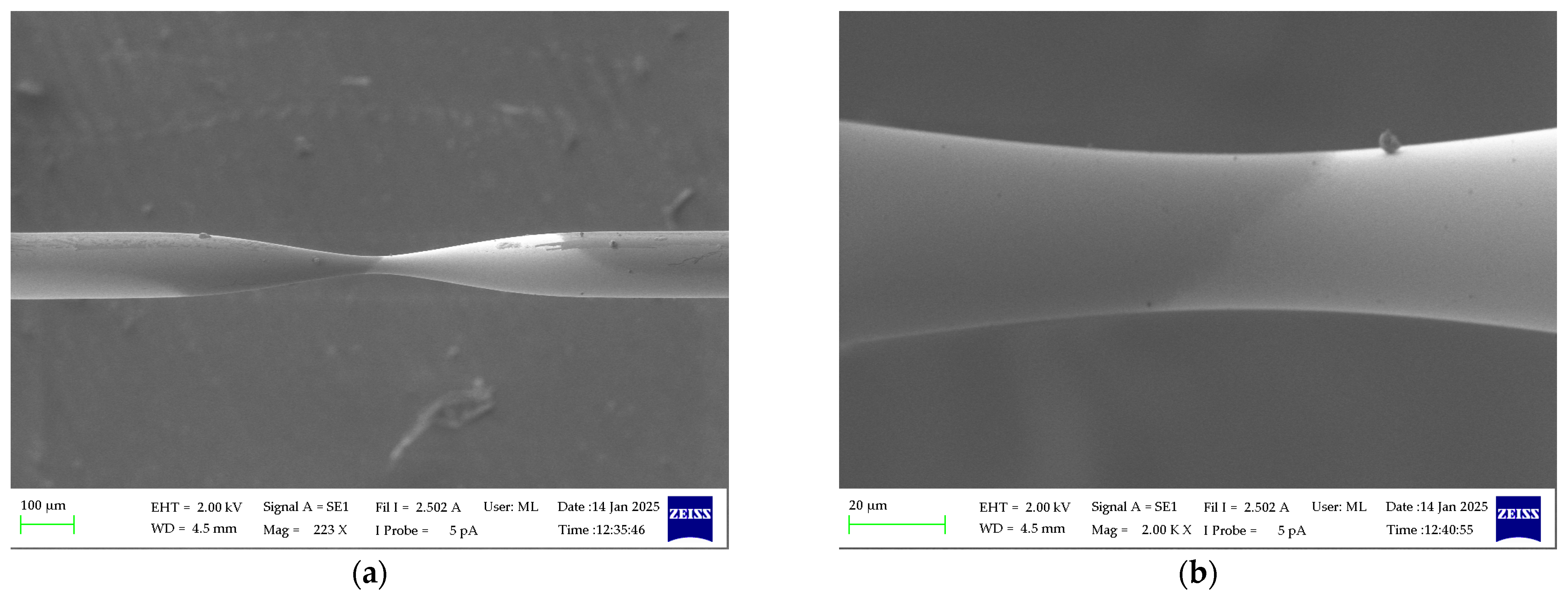
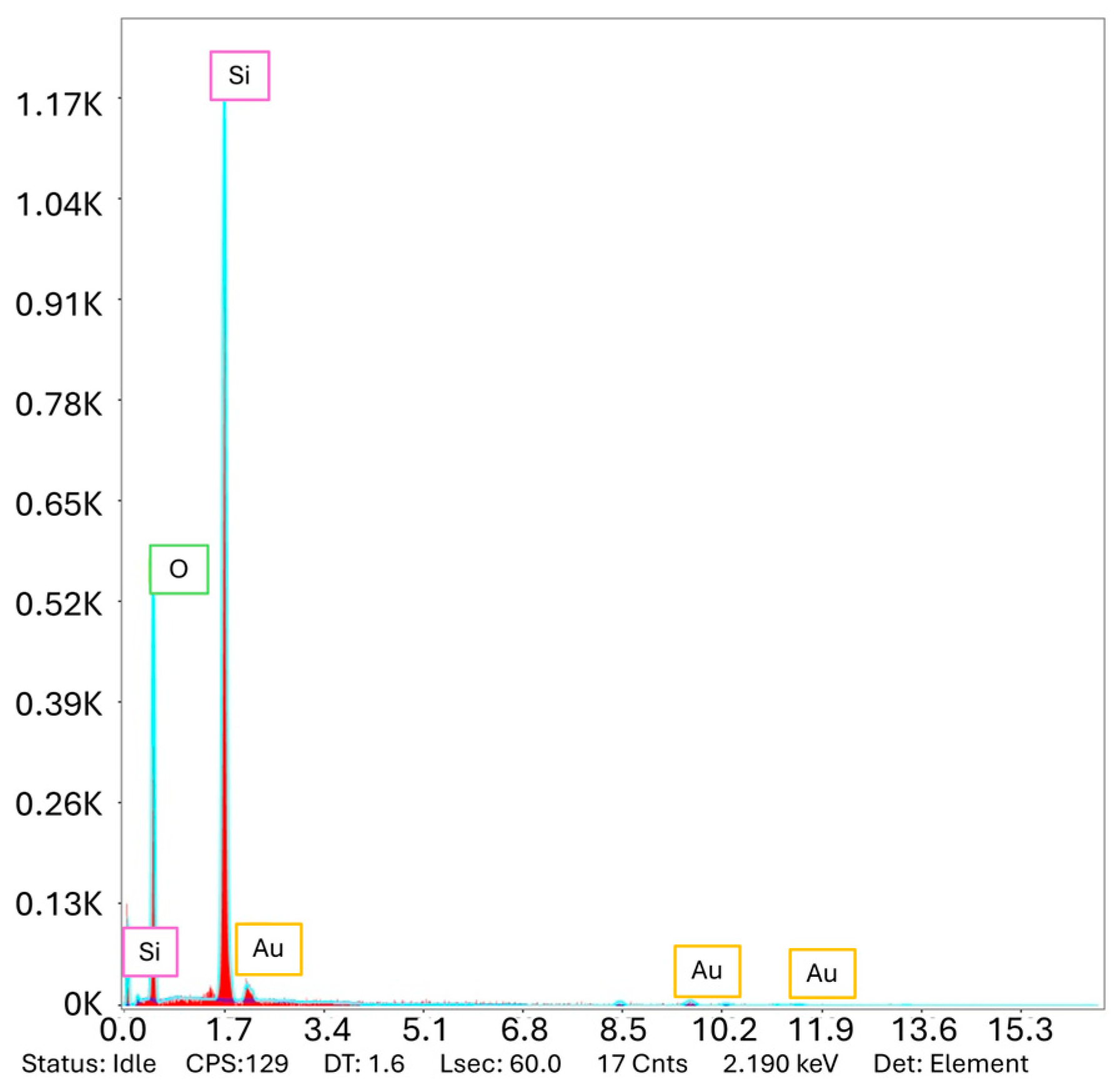
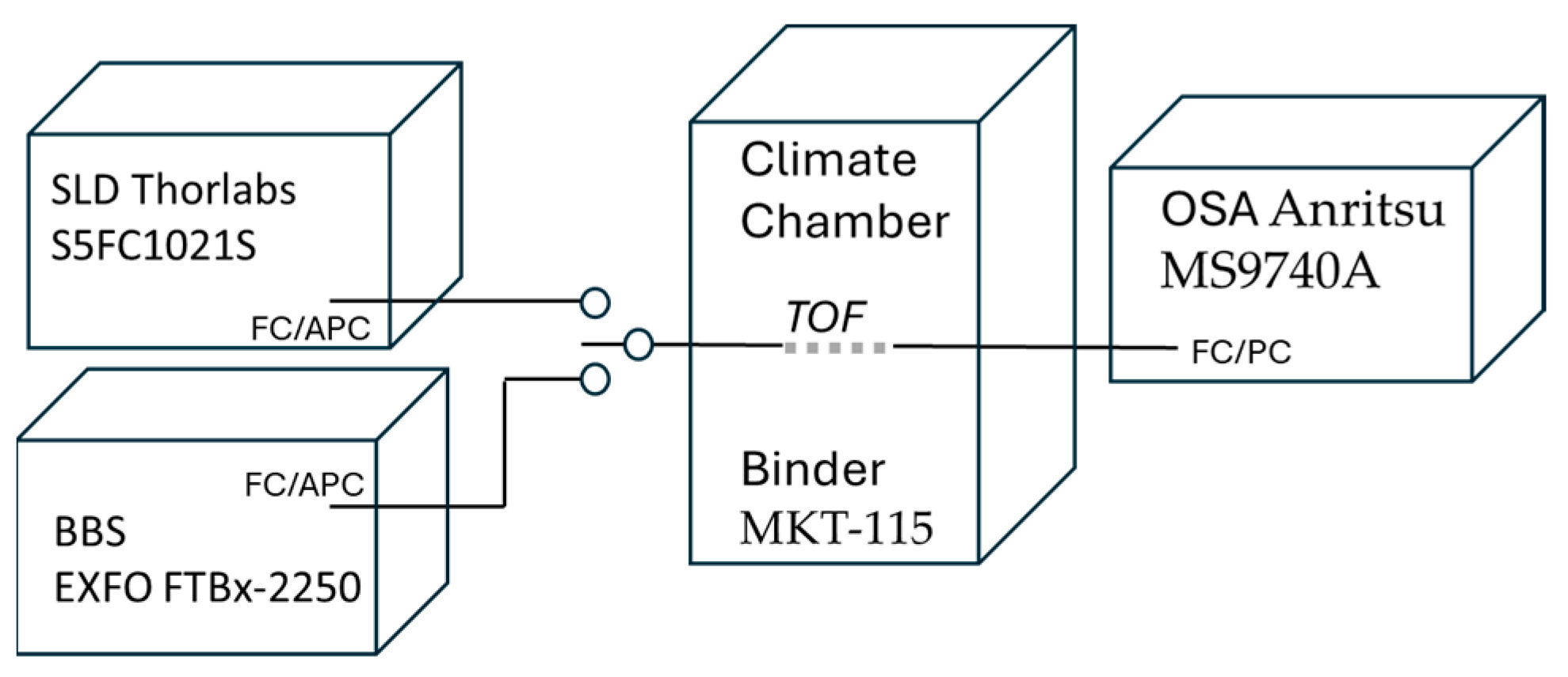

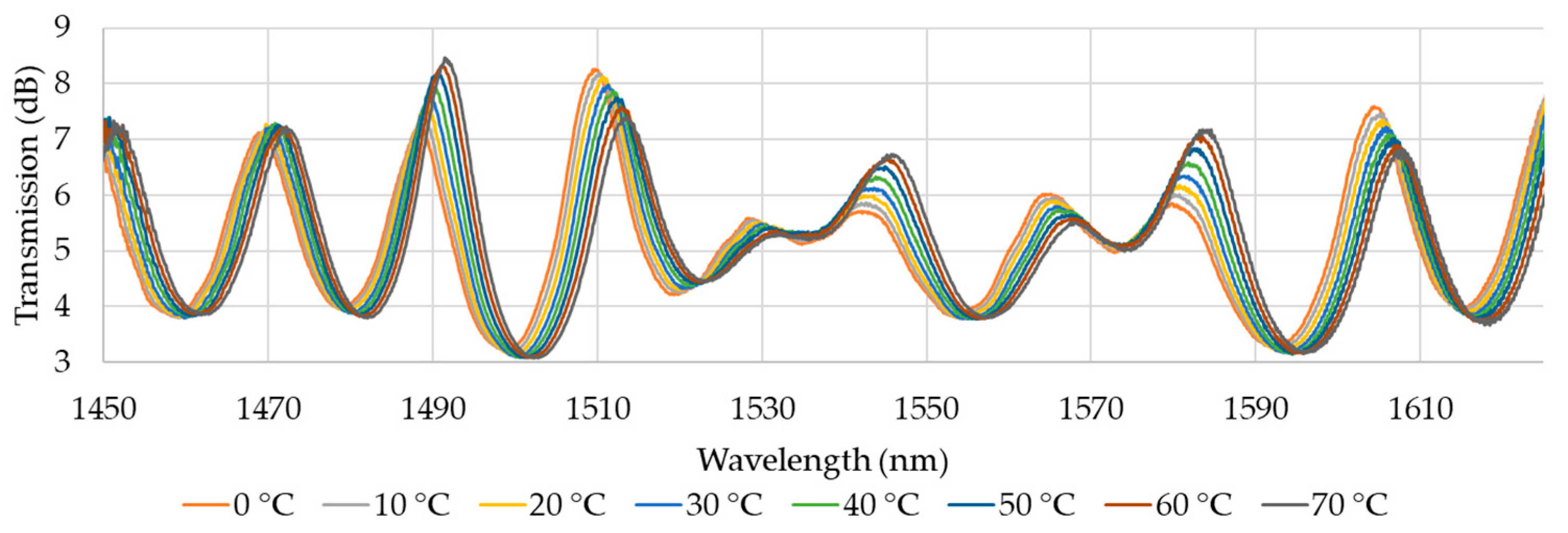

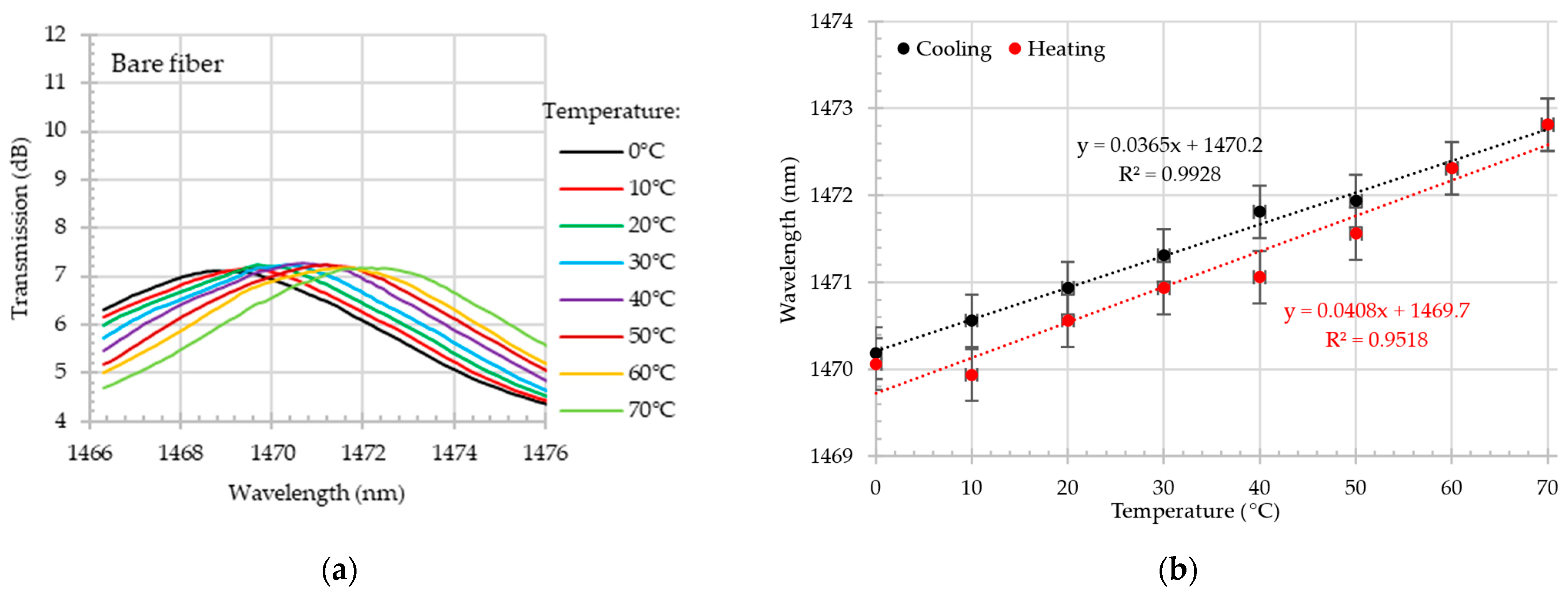
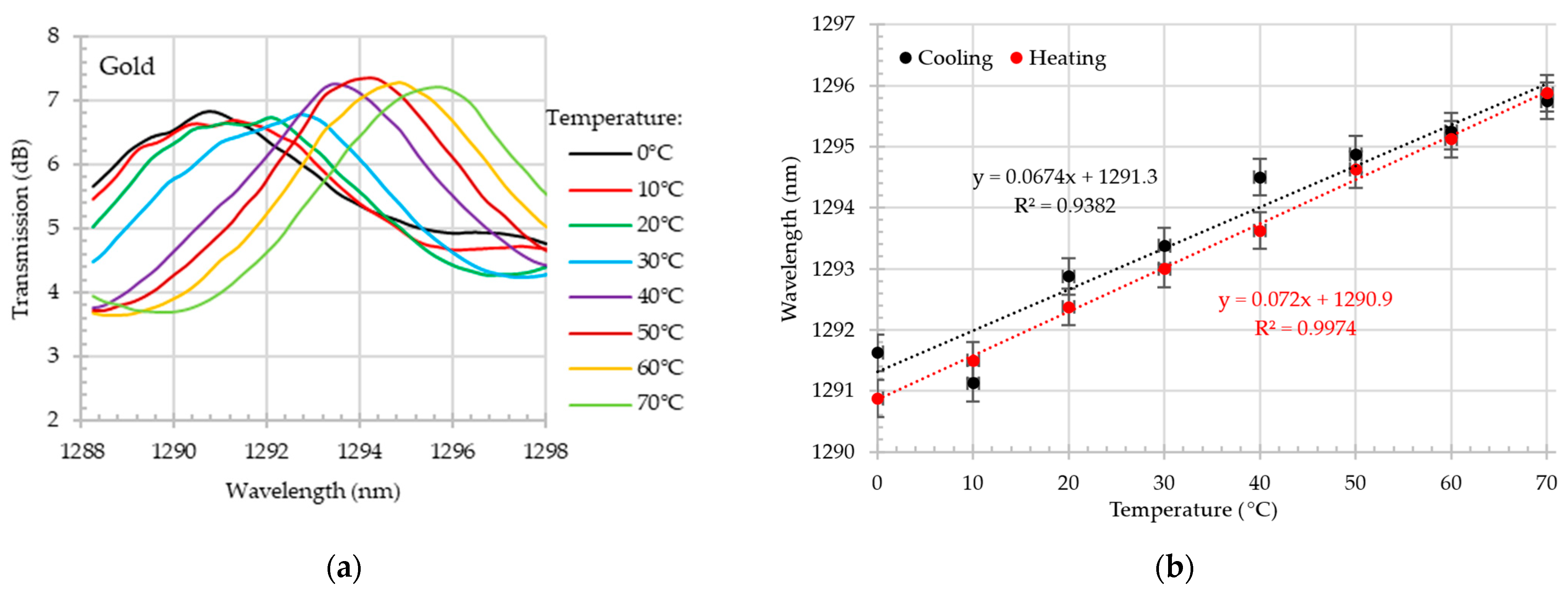
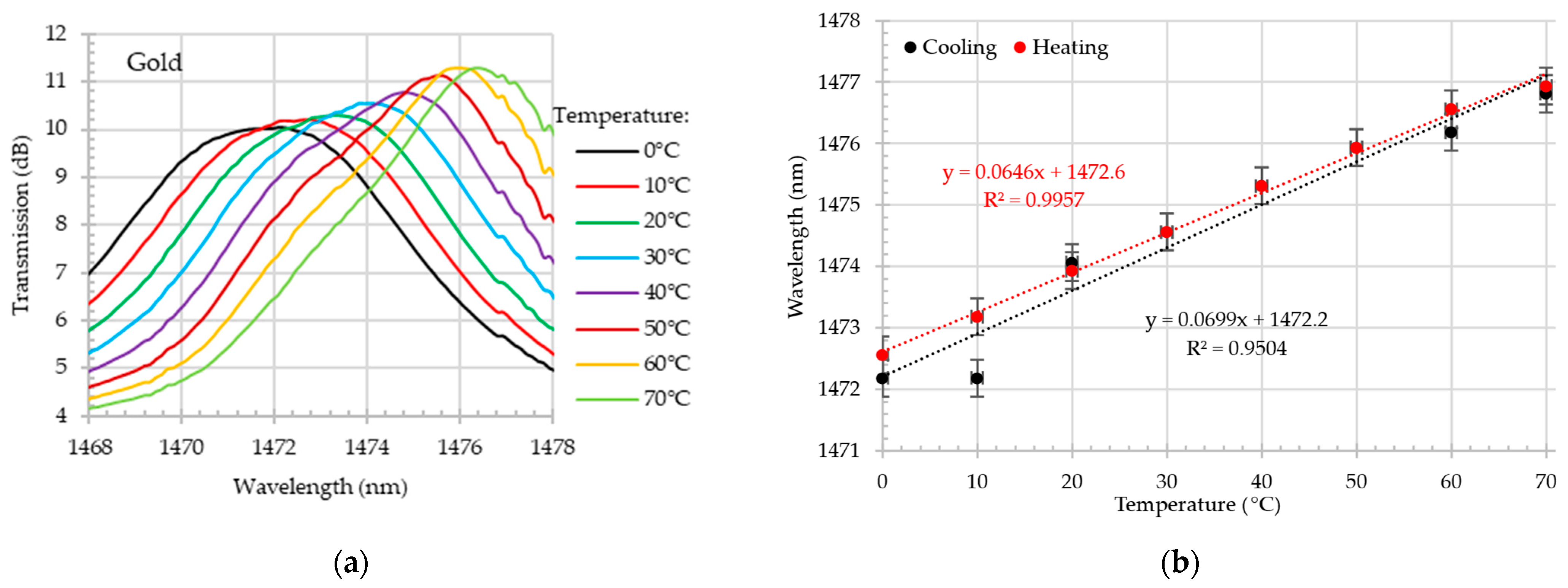
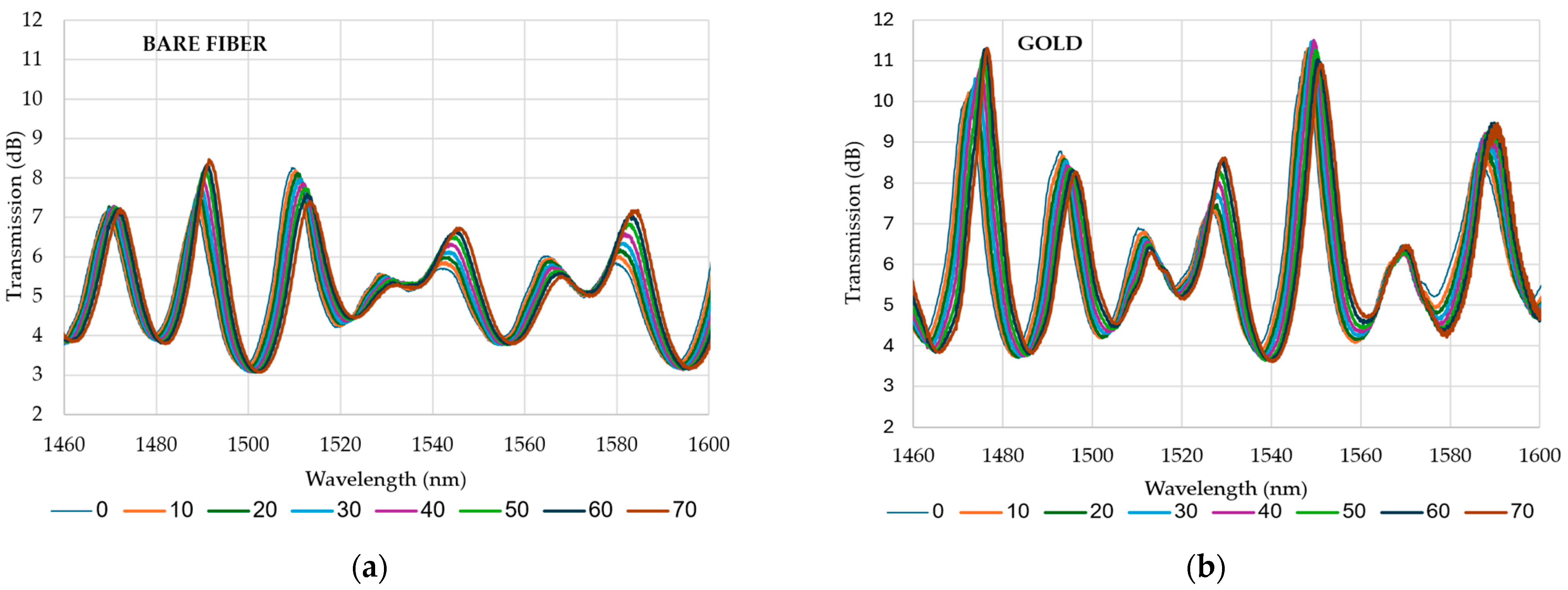
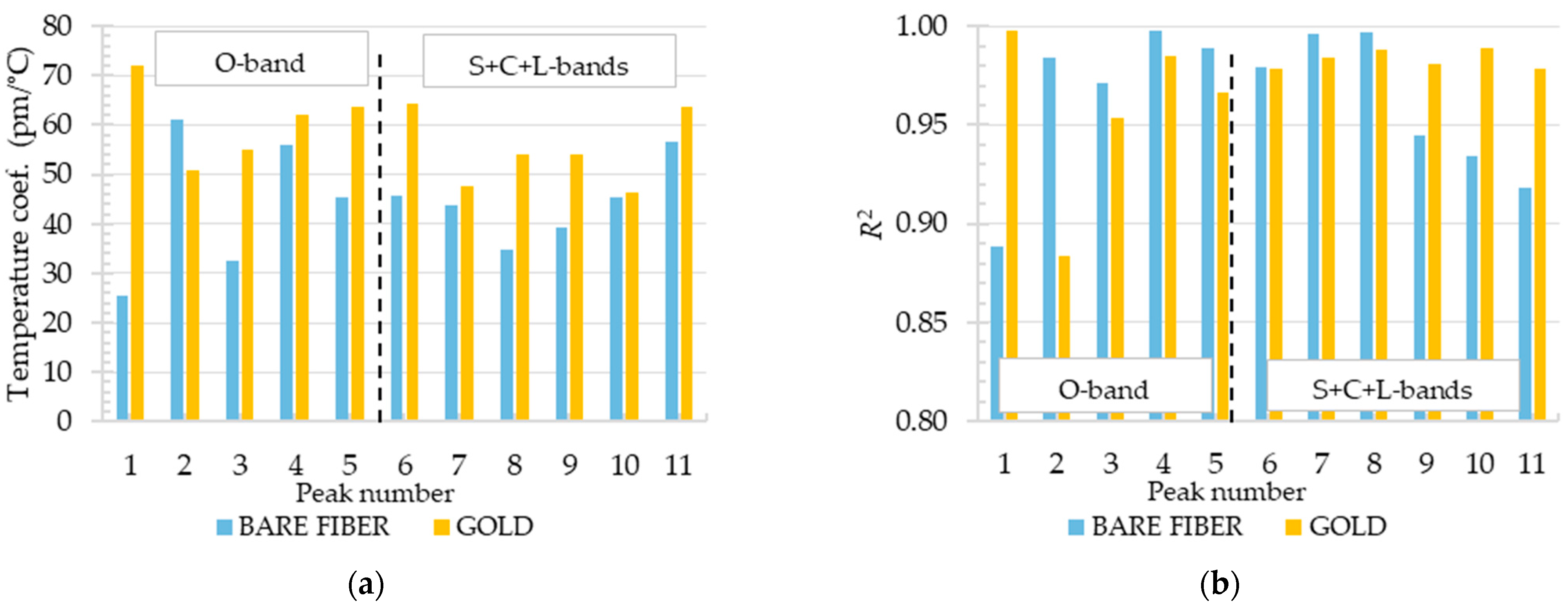
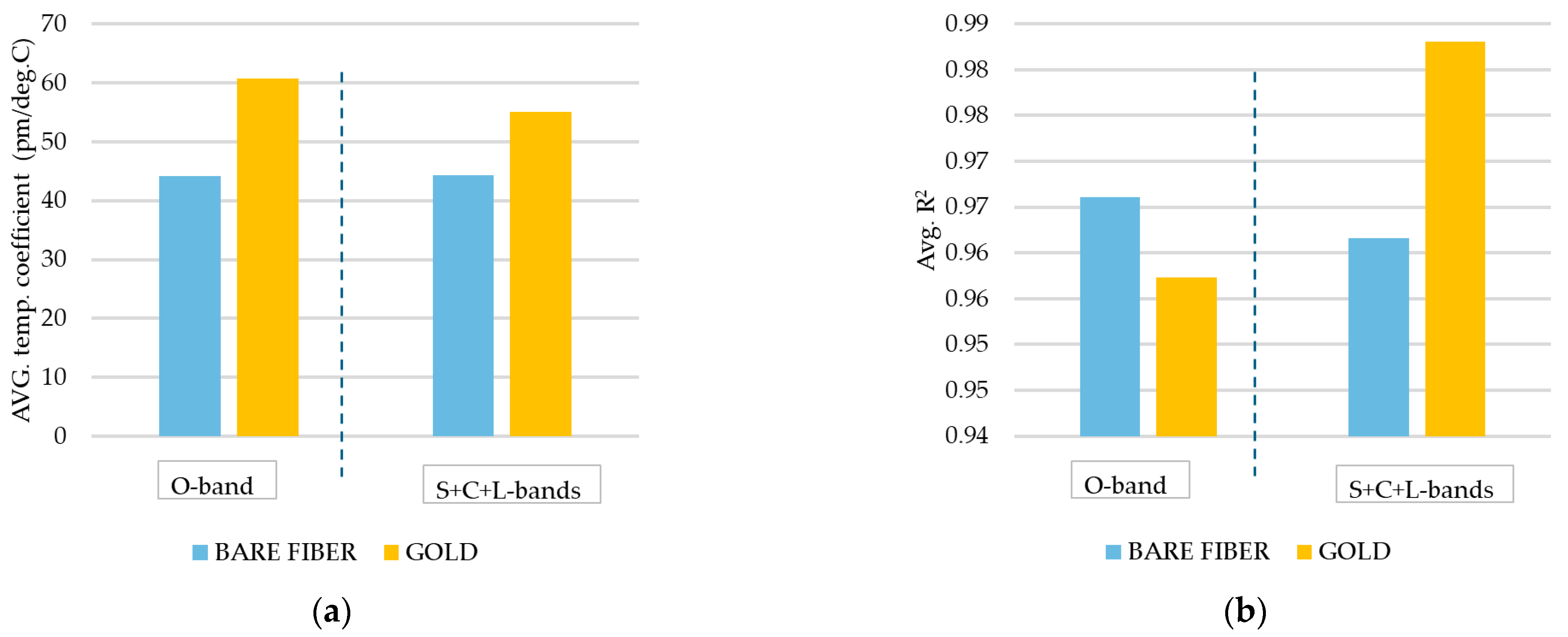
| Parc [mW]/tarc [s] | Waist Diameter d [µm] | Waist Length l [cm] | Space lS [cm] |
|---|---|---|---|
| 20/1.4 | 46 ± 1 | 0.74 | 2.4 |
| 30/1.4 | 33 ± 1 | 0.70 | |
| 20/1.6 | 42 ± 1 | 0.65 | |
| 30/1.6 | 26 ± 1 | 0.60 |
| Band | ∆neff | L [cm] | λ [nm] | Theoretical FSR [nm] | Experimental Avg. FSR [nm] |
|---|---|---|---|---|---|
| O-band | 0.0047 | 3.2 | 1312 | 11.3 | 10.8 |
| S+C+L-band | 0.0042 | 3.2 | 1583 | 18.6 | 19.2 |
| Type of Sensor | Sensitivity | Ref. |
|---|---|---|
| Two tapers in series made on SMF | 13.4 pm/°C | [62] |
| Tapered multicore fiber between two SMF | 39.3 pm/°C | [63] |
| Tapered few modes fiber between two SMF | 36.8 pm/°C | [64] |
| Tapered Multi-thin Multi-mode Fiber | 75.04 pm/°C | [65] |
| MZI coated with polydimethylsiloxane | 101 pm/°C | [66] |
| Two-mode fiber MZI | 70 pm/°C | [67] |
| Multi-tapered PMF | 78 pm/°C | [68] |
| MZI & FBG | 35.18 pm/°C | [69] |
| Inline-MZI embedded point-shaped taper | 73 pm/°C and 169 pm/°C | [70] |
| SMTMS | 145.8 pm/°C | [71] |
| Gold-coated TOF on SMF | 60 pm/°C (O-band) 55 pm/°C (S+C+L-bands) | This study |
Disclaimer/Publisher’s Note: The statements, opinions and data contained in all publications are solely those of the individual author(s) and contributor(s) and not of MDPI and/or the editor(s). MDPI and/or the editor(s) disclaim responsibility for any injury to people or property resulting from any ideas, methods, instructions or products referred to in the content. |
© 2025 by the authors. Licensee MDPI, Basel, Switzerland. This article is an open access article distributed under the terms and conditions of the Creative Commons Attribution (CC BY) license (https://creativecommons.org/licenses/by/4.0/).
Share and Cite
Guzowski, B.; Lakomski, M.; Peczek, K.; Ruta, L.; Sibinski, M. Gold-Coated Temperature Optical Fiber Sensor Based on a Mach–Zehnder Interferometer for Photovoltaic Monitoring. Materials 2025, 18, 1818. https://doi.org/10.3390/ma18081818
Guzowski B, Lakomski M, Peczek K, Ruta L, Sibinski M. Gold-Coated Temperature Optical Fiber Sensor Based on a Mach–Zehnder Interferometer for Photovoltaic Monitoring. Materials. 2025; 18(8):1818. https://doi.org/10.3390/ma18081818
Chicago/Turabian StyleGuzowski, Bartlomiej, Mateusz Lakomski, Krzysztof Peczek, Lukasz Ruta, and Maciej Sibinski. 2025. "Gold-Coated Temperature Optical Fiber Sensor Based on a Mach–Zehnder Interferometer for Photovoltaic Monitoring" Materials 18, no. 8: 1818. https://doi.org/10.3390/ma18081818
APA StyleGuzowski, B., Lakomski, M., Peczek, K., Ruta, L., & Sibinski, M. (2025). Gold-Coated Temperature Optical Fiber Sensor Based on a Mach–Zehnder Interferometer for Photovoltaic Monitoring. Materials, 18(8), 1818. https://doi.org/10.3390/ma18081818







